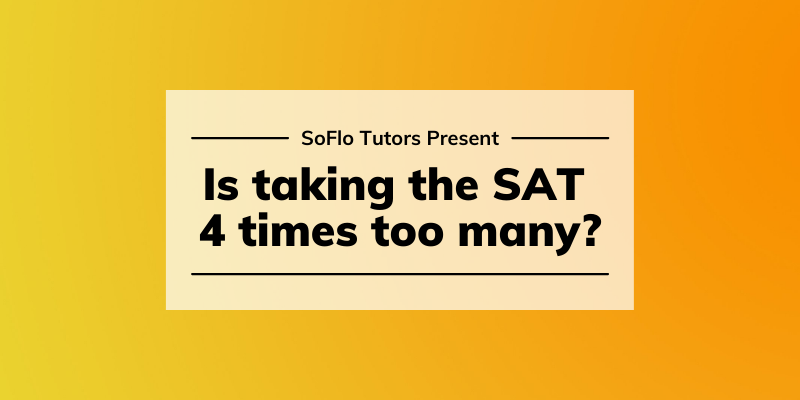
SoFlo recommends but doesn’t require that students take the SAT three times at most. Most students will plateau after the third attempt, but if a student is close to a certain cutoff score it justifies taking the SAT four or more times. The SAT does not place any limits on how many times a student can sit for the exam and students can superscore their best sections or choose which test scores to include in college applications, so there are many benefits to taking the SAT multiple times if needed.
Why Would a Student Take the SAT 4 Times?
- Some students who are close to specific cutoff scores in order to qualify for scholarships like Bright Futures should strongly consider attempting the SAT multiple times. Students have until May of their senior year in high school to earn the Bright Futures Scholarship, so even after the college application process has passed, students can and do sit for the SAT a 4th or 5th time to earn scholarship money.
- Student athletes who need certain qualifying scores may also take the SAT multiple times, as NCAA scholarships require athletes to score above a certain SAT or ACT cutoff score in order to qualify for it. The NCAA utilizes a “sliding scale,” meaning it allows students to calculate the SAT or ACT combined score they need along with their current core-course GPA to be NCAA eligible to a Division 1 or 2 school as university freshmen.
- Students who are applying to specific programs in colleges may also choose to take the SAT multiple times in order to reach and surpass the minimum score needed for acceptance. If a certain program requires a 1350, and the student’s highest score or superscore is 1340, students and parents shouldn’t let the 10 point difference determine their ability to apply for a certain program. Students in this situation should keep taking the exam to boost their score.
Benefits of Taking the SAT Multiple Times
Students are likely to see a large and considerable increase in their scores between the first and second tests. Why? The SAT is largely formulaic, meaning there are certain patterns that students can recognize and prepare for. Beyond naturally picking up on some of the bigger patterns in each SAT, students can also use their experience from their first exam when they are studying for their next attempt. Taking the SAT for the first time can feel unfamiliar and daunting, and many students also face test day anxiety and feel nervous when they sit for the test for the first time. However, like any task, practice makes perfect. If a student has taken the exam before, he or she is likely to understand and be more familiar with the overall process, which could lessen nerves and improve performance. For example, students may better understand what to bring to the SAT the second time around.
SoFlo strongly encourages taking the SAT at least twice in order to account for the students’ increased familiarity with the exam; we also recommend taking the test at least three times in order to ensure that the student has scored his or her highest score possible. Taking the SAT three times also means that students can superscore their best sections. Superscoring means that the highest score from each section, regardless of which attempt they belong to, are combined into one superscore. Students will then be able to send the maximum composite score to a university in their application (if the college allows for superscoring).
Why We Discourage Taking the SAT 4 Times
In most instances, students do not improve enough on the 4th exam to warrant the stress of sitting for the exam again. Normally, students plateau after the 3rd attempt and will reach their potential within the 3 times they take the SAT or ACT. While taking the test again in order to boost a score by 10 points makes sense if that is all the student needs to qualify for a program or scholarship, chasing a 10 point difference just to improve a score by a little is not worth it. Going from 1490 to 1500 is not a huge leap, and the SAT is a time commitment and mental burden on the student. Instead of taking the exam for the fourth time, a student should consider diverting that time and energy into other pursuits like their academics and extracurriculars. While test scores are an important part of the application process, colleges also strongly consider and rely on indicators of involvement in students’ schools and communities. Understanding that a student’s score has likely reached its maximum potential after the third attempt will open the door to invest more brainpower into other, also important, activities.
University admissions officers can also understand that some students are not inherently strong test-takers but have many strengths in other areas. Not having the “ideal score” may place stress onto students who are already nervous about the college admissions process, but once a student has attempted to take the SAT multiple times, the student should not beat themselves up about his or her scores and instead focus on creating a strong personal narrative of all of their strengths, whether those are related to their SAT scores or not.
This being said, there are situations in which a student will be able to raise their scores, even after the 4th time. Each student is different, and each SAT test is different. An infinite number of factors can influence how well a student performs on the SAT, and one slight change in one of those factors can be the difference. If a student has studied in a different manner or has practiced a significant amount following their third attempt, taking the SAT a fourth time might be the right decision. However, students should not take the SAT for the fourth time if they have not changed any of their study patterns or switched to a different approach, as the difference will likely be minimal and that time could be better spent elsewhere.
Do Colleges See How Many Times You Take the SAT? Do Colleges See All of a Student’s SAT Scores?
Most colleges allow students to choose which of their scores they would like to send to each university in a process known as score choice. While it varies by institution, the majority of schools allow the students to pick and choose the best scores that they want to submit as part of their application. Some schools request to see all of a students’ past scores, but this should not worry students for the most part, especially if the student has seen major growth between their first and most recent attempts. If universities are able to see that a student has persevered and studied in order to improve their score by a significant amount, this can be a testament to how the student may perform at that school. Barnard College in New York is an example of a school that recommends all SAT or ACT scores, but for the most part, many schools give score choice the okay. If a student has his or her heart set on a specific school, I recommend looking up their score policy beforehand. The school will list their score policies, including information about both superscores and score choice, on their website and should be relatively easy to locate. There is no penalty for taking the SAT multiple times, which is why SoFlo recommends taking the SAT three times.
What Students Can Do to Improve Their Test Scores Before Their Next Attempt
Practice
Practice makes perfect, and since the SAT follows a very specific pattern, taking practice tests and completing SAT section drills can help students increase their understanding of the material and exam structure. Practice will also help calm students’ test anxiety to a certain extent, as students will feel more comfortable and familiar with the exam. I recommend practicing with full-length test runs with a timer as the date of the SAT approaches or working with an online sat tutor. Sitting down and completing a full SAT practice test can sound draining and unappealing, but taking the whole test in one sitting is the best way to replicate the SAT exam conditions on the day it matters. Ideally, students should also limit their time allowance to how long they would receive on each section of the actual test in order to see if there are any issues with timing. Rushing at the end of the test not only prevents students from answering all of the questions, but it also can cause those panicked feelings to resurface, which could negatively affect the remaining portions of the test.
Focus on Problem Areas
Another way to target specific areas on the SAT is to review the student score report. When students receive their SAT scores, CollegeBoard releases a score report that contains a multitude of information about their test and what kinds of questions they answered wrong. Reviewing these can offer a great starting point when students are studying for their second or third attempt, as it can narrow down where they should focus. Understanding areas of weaknesses is the best way to target them and offers the opportunity to complete specific drills to perfect any problem concepts.
Reduce Test Anxiety
Different students have different ways of relaxing, but test-takers should always put aside a little bit of time before the exam in order to calm their anxiety and maintain a clear head. Before I took my SAT, I put things in perspective: there is no penalty for taking the SAT multiple times! If I had an off day, it might be disappointing to see that I didn’t achieve the score I wanted to, but at the end of the day I know I can improve and I don’t have a strictly limited number of times to take the exam. Whether it is through meditation, breathing exercises, or talking with a friend or parent, students should try their best to acknowledge and reduce their test anxiety.
About the Author: Emily Moon is an expert SAT & ACT tutor at SoFlo Tutors. Emily studies Communications and Consumer Psychology at the University of Pennsylvania. She was a National Merit Scholar in high school, scored 1580 on the SAT, and scored an 800 on the SAT Literature Subject Test. She keeps busy writing music articles for 34th Street Magazine or writing social media copy for the Institute of Contemporary Art. In her free time, she enjoys listening to music, painting, or playing the guitar.











